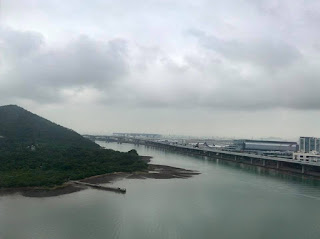Mein letzter Tag in Hongkong, es regnet, es ist schwül und mein Flieger geht am Abend und ich möchte den großen Buddha besuchen. Der Tian Tan Buddha wohnt auf der Insel Lantau, dahin fahre ich mich mit der U-Bahn und später mit der Gondelbahn über die unberührte Berglandschaft.
Allerdings hatten viele Leute diese Idee und so ein bisschen Regen schreckt hier niemanden, eher im Gegenteil, man bekommt überall so praktische Regenponchos für kleines Geld. Und vielleicht war es gerade der Regen, der diesen Ausflug so besonders gemacht hat, die verhangenen Bergtäler, die aufsteigenden Nebelschwaden und die Gräue des Lichts erzeugen eine Atmosphäre, wie es strahlender Sonnenschein nicht vermag.
Der Buddha ist der größte in Hong Kong, einer der fünf Großen in China. Er sitzt auf einer Lotusblüte auf einem Berg am Kloster Po Lin und verdeutlicht die Harmonie zwischen Mensch, Religion und Natur, oder Natur, Mensch und Religion.
Der Buddha wurde in den 80er Jahren erbaut und 1993 geweiht. Als Besucher kann man zur Aussichtsplattform hochsteigen und den Buddha umrunden und ich hatte an jenem 13. November 2017 einen wundervollen Ausblick auf eine etwas verwunschen wirkende Landschaft im Nebel.
Die Figur ist 34 Meter hoch, die rechte Hand ist erhoben als Geste der Zurückweisung des Leidens und die linke Hand liegt im Schoß als Geste des Gebens. Sechs kleinere Bronzestatuen umgeben den Buddha, sie stellen Heilige oder Unsterbliche dar, die dem Buddha symbolträchtige Gegenstände entgegenhalten.
Außerdem wird der Buddha umrundet von vielen kleinen weißgewandeten Menschenwesen, die in ihren Regenumhängen wie eine Armada von außerirdischen Besuchern anmuten.
Zurück im Dorf gönne ich mir eine vegetarische Mahlzeit, das ist in der Nähe von buddhistischen Einrichtungen immer recht einfach und zuverlässig. Das vegetarische Essen ist dann wirklich fleischfrei, außerdem war es sehr lecker und nun ist es Zeit, ins Hotel zurück zu kehren, mich auszuwringen, meine Sachen zu packen und zu Flughafen zu fahren.
Hier und nun geht meine Kreuzfahrt zu Ende. Es war ein fabelhaftes Abenteuer, mit Startschwierigkeiten und interessanten Einblicken in meine Art zu Reisen, Entschleunigung muss ich noch lernen, und auch, dass bei bestimmten Formen des Reisen, die Flexibilität in der Gestaltung reduziert ist.
Ich bin froh und glücklich, nach Hongkong gereist zu sein, denn nach der derzeitigen politischen Entwicklung, wird es das Hongkong, das ich kennen lernen konnte, nicht mehr geben wird. Momentan gehe ich davon aus, Hongkong nicht wieder besuchen zu können. Aber eine Kreuzfahrt möchte ich wieder machen.
English version below.
It´s my last day in Hong Kong, it´s raining, it´s humid and my flight will only leave late at night and I want to see the Big Buddha. The Tian Tan Buddha lives on Lantau Island, I will go there by subway and later by rope way, riding high above an untouched mountain landscape.
It turns out that many people had the same idea and that little bit of rain dosen´t bother anybody, more opposite, you get kind of fancy rain suits for very little money. And maybe it was the rain that made those trip so special, the cloudy valleys, the rising fog, the drab sky created an atmosphere no sunny day ever could have.
The Buddha is the largest in Hong Kong and one of the big five in China. He is sitting at a lotus flower on a hill top near the Po Lin monastery and symbolise the harmony between men, religion and nature or between nature, religion and men.
The Buddha was built in the 80s of the last century and sacred in 1993. As a visitor you can climb up to the observation platform ans circle around the Buddha, and me, at this special day on November the 13th 2017 had a wonderful view onto an enchanted appearing landscape in the mist.
The statue is 34 meters high, the right hand is lifted in a gesture of rejection of suffering and the left hand is resting in his lab as symbol of giving. Six smaller statues are surrounding the big Buddha, they are saints or immortals and offering the him items of symbolic importance.
Additional many tiny white cloaked human beings are circling around the Buddha like an armada of aliens.
Back at the village I get me a vegetarian meal, what is quite easy at Buddhist places and you can be very sure, the meal is free of meat, and it was very tasty and now it´s time to go back to my hotel room, wring out myself, pack my things and head to the airport.
Here and now my cruise came to an end. It was a fabulous adventure with a bit difficulties from the start and interesting insights in my way of traveling, slow movement is something I still have to master and that with those special kind of journey the flexibility of designing is limited.
I´m so very happy, that I went to Hong Kong, because it´s changing and due to the political development the Hong Kong I knew might vanish. At the moment I´m very sure, I won´t see Hong Kong again. But I will definitely do a cruise again.

























































































































